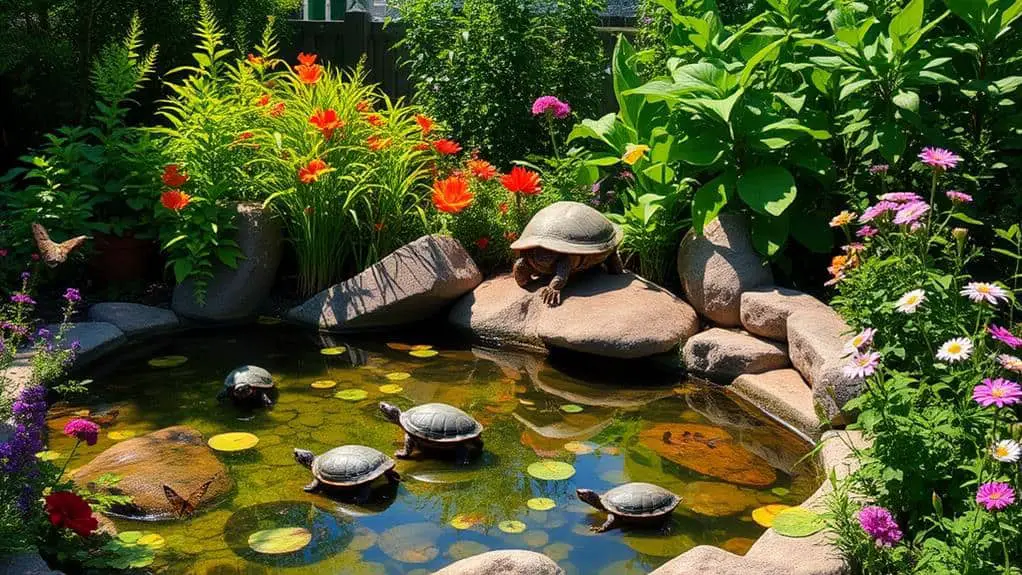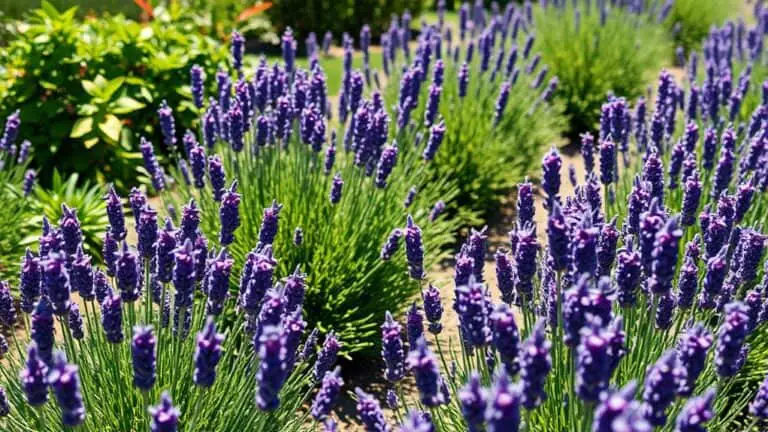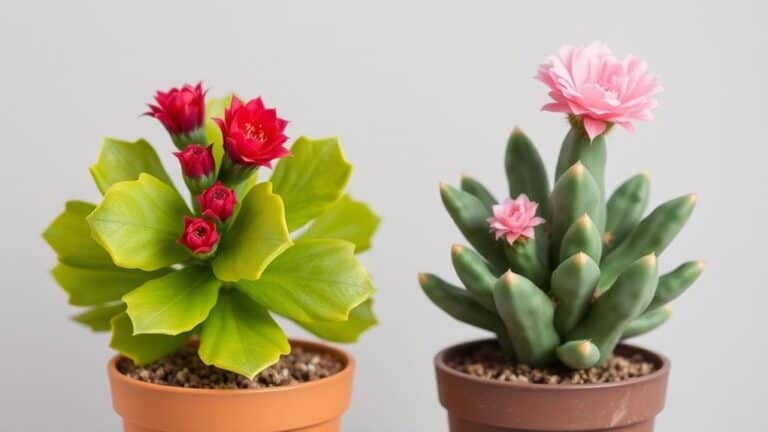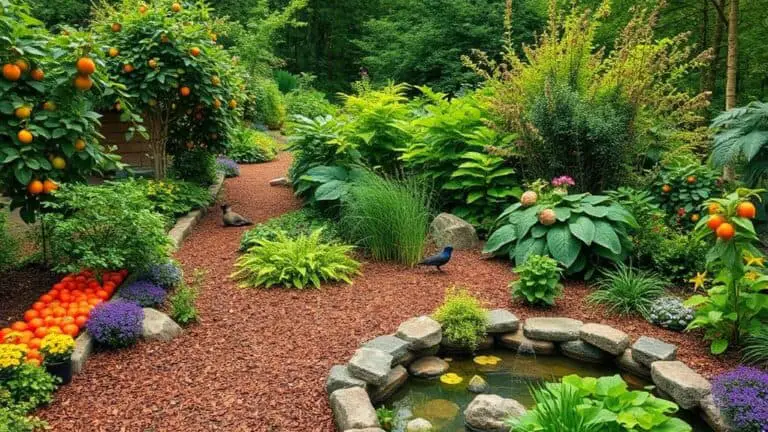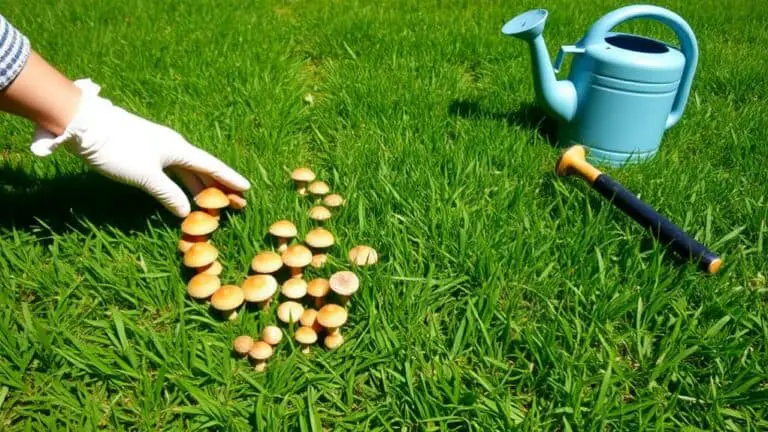Why You Should Get Spotting Turtles For Your Yard
If you've ever considered enhancing your yard's ecosystem, inviting spotting turtles might be an excellent start. These creatures are incredible natural pest controllers, often reducing mosquito larvae by an impressive margin. Best of all, they contribute to a balanced food web and increased biodiversity, setting the stage for a healthier environment. Imagine turning your outdoor space into a sustainable haven without resorting to harmful chemicals. Interested in how you can attract these fascinating turtles and the additional benefits they bring? Let's explore further.
Benefits of Turtles for Pest Control
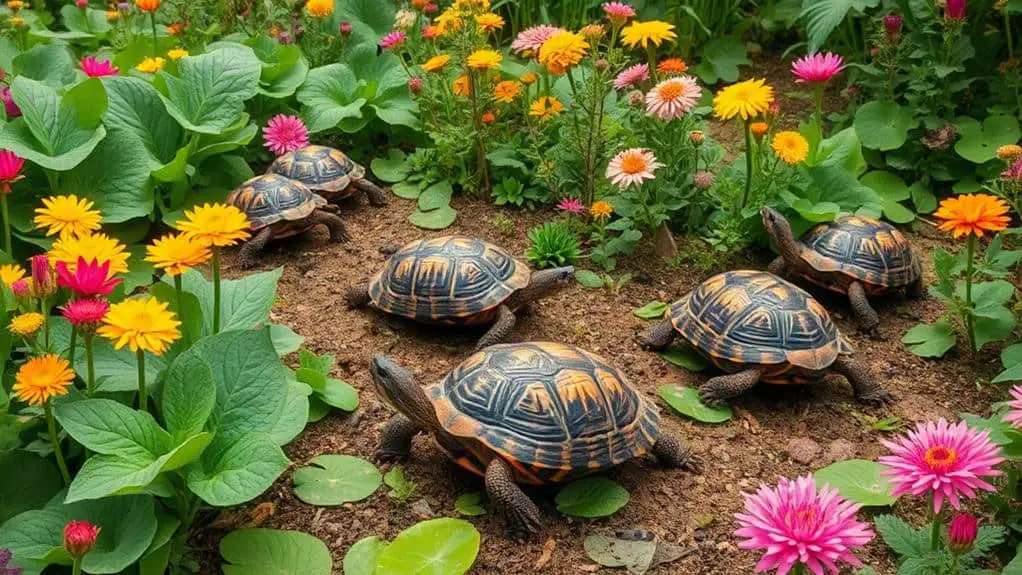
When it comes to natural pest control in your yard, turtles offer an effective and eco-friendly solution.
They're particularly good at eating mosquito larvae, which can reduce their population by up to 99%. This makes turtles a natural form of pest control.
Freshwater turtles, like red-eared sliders, actively consume insect larvae, helping to manage pests naturally. By doing this, they maintain an ecological balance, preventing any single species from overpopulating. This contributes to a healthier garden ecosystem.
Plus, using turtles instead of chemical pesticides protects non-target species and promotes biodiversity. Their presence supports a balanced food web, enhancing the overall health of your yard while managing pests naturally.
Attracting Turtles to Your Yard
To attract turtles to your yard, start by creating a water source like a pond or water garden for them to drink and nest.
Adding native plants, rocks, and logs gives turtles places to hide and bask in the sun.
Also, make sure to avoid using chemicals, as these can harm the turtles and keep them away.
Water Sources Essentials
One of the crucial steps in attracting turtles to your yard is creating a reliable water source. A small pond is perfect for this.
Turtles need both shallow areas for basking and deeper spots for swimming. This variety helps cater to the different needs of various turtle species. Adding aquatic plants can make the pond even more inviting by providing food and shelter. Plus, these plants help keep the water clean.
Don't forget, regular maintenance is key—clear out debris and maintain fresh water. Researching local turtle species will guide you in designing the best habitat.
Safe Basking Areas
Creating safe basking areas is essential for attracting turtles to your yard. Wild turtles need spots where they can sunbathe and regulate their body temperature.
I recommend using flat rocks or logs in sunny areas. Confirm these basking spots are near water sources, so turtles can easily hydrate and cool off after soaking up the sun.
Surround these areas with native plants to provide shade and shelter, making the habitat more inviting for a little turtle.
It's important to keep these places free from chemicals and pesticides, as they can harm turtles.
Observing local turtle species will help you design a basking area tailored to their specific needs, increasing the chances they'll visit your yard.
Safety With Wild Turtles

When it comes to wild turtles in your yard, it's important to be careful while still enjoying their presence.
Wild turtles can carry germs like Salmonella, so try not to handle them too much and always wash your hands if you do.
If you need to move a turtle, use gloves or a towel, and make sure to do it gently to keep both you and the turtle safe.
Handling Tips
Although encountering a wild turtle in your yard can be an exciting experience, it's important to handle these creatures with care to guarantee both their safety and yours.
First, keep an eye on the turtle from a distance to avoid stressing it. If you must handle one, use gloves or a towel to gently pick it up, making sure to wash your hands afterward.
Never interact directly with snapping turtles, as they can be defensive. If you find a turtle crossing a road, assist it only if it's safe and after nesting.
Contact a local animal rehabilitator if you find an injured or dangerous turtle.
These handling tips will help promote a safe and enjoyable experience for both you and the turtle.
Disease Concerns
While handling tips are critical for guaranteeing a safe interaction with turtles, it's equally important to be aware of potential disease concerns. Wild turtles, especially those you spot in your yard, can carry germs like Salmonella. It's best to observe from a distance. If you need to move a turtle, use gloves or a towel. This helps prevent contamination. Snapping turtles need extra care since they can bite.
| Guideline | Why It's Important |
|---|---|
| Observe from a distance | Minimizes stress on turtles and reduces risk |
| Use gloves or a towel | Prevents direct contact and contamination |
| Handle with caution | Essential for snapping turtles due to biting risk |
| Contact rehabilitators | Guarantees safety for you and the turtle |
For the past two years, these practices have kept my yard safe.
Turtle Behavior and Ecology
Turtles are fascinating creatures with distinct behaviors that are essential for their well-being. One important aspect is their foraging behavior. Turtles naturally forage for insects and aquatic plants, which keeps them healthy.
Understanding their habitat preferences is key to creating a welcoming environment. For instance, red-eared sliders and painted turtles often thrive in yards with shallow ponds.
Turtle socialization patterns reveal that they're mostly solitary. They interact mainly during mating season or when nesting. By knowing this, you can guarantee they've the space they need.
A study showed that red-eared sliders can reduce mosquito larvae by 99%, making them great for pest control. With these insights, you can support these creatures in your yard effectively.
Environmental Impact of Turtles
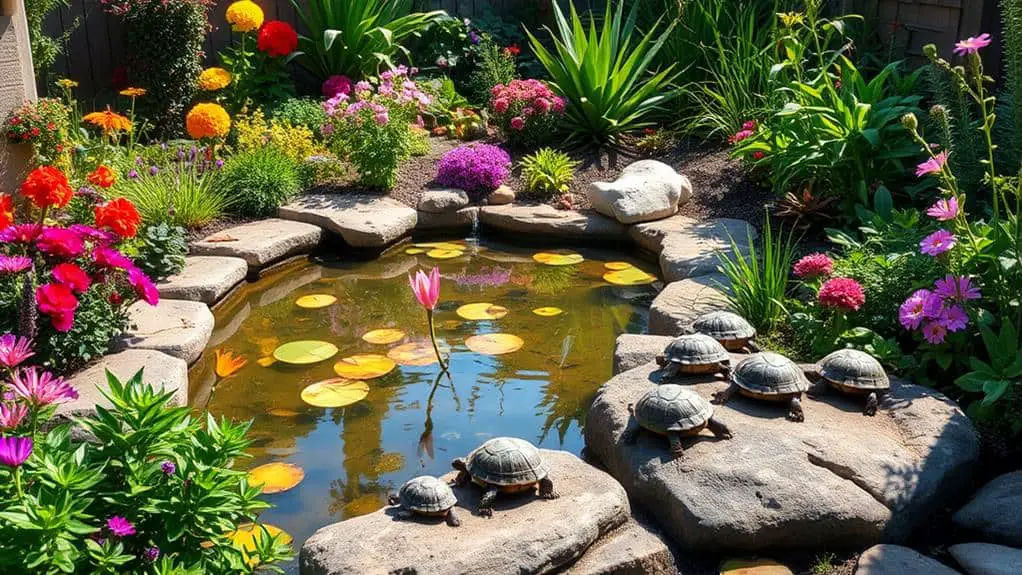
Having turtles in your yard can be a fantastic way to control pests naturally, especially mosquitoes, since turtles like red-eared sliders can reduce mosquito larvae by 99%.
They also help keep the ecosystem balanced by preventing any one species from taking over, which boosts biodiversity.
Natural Pest Control
Imagine stepping into your yard and finding a natural ally in the fight against pests: turtles.
Turtles offer incredible benefits, especially when it comes to mosquito control. Did you know that red-eared sliders can reduce mosquito larvae populations by up to 99%? This means fewer annoying mosquitoes buzzing around.
Turtles help maintain ecosystem health by eating insect larvae, promoting a balanced food web. Plus, using turtles for pest control is an eco-friendly alternative to chemical pesticides, which can harm non-target species and pollute the environment.
Enhancing Biodiversity
While natural pest control is a fantastic benefit of having turtles in your yard, there's another significant advantage: enhancing biodiversity.
By attracting different turtle species, you create a habitat variety that supports a wide range of ecosystem interactions. Turtles play a dual role in the food web, acting as both prey and predator, which helps maintain ecological balance. They also contribute to healthier wetland ecosystems, essential for many other species' survival.
Encouraging turtles in your yard fosters a resilient environment, reducing the need for harmful pesticides and promoting natural pest management.
As you support these amazing creatures, you're also enhancing overall ecosystem health, making your yard a vibrant, thriving space for plants and animals alike.
Western Pond Turtle Overview
Understanding the Western Pond Turtle is essential for anyone looking to contribute to its conservation. These turtles, native to the West Coast, are endangered and need our help.
Turtle conservation efforts focus on protecting these small creatures, which measure 4 to 8 inches and have distinctive green-brown shells. Habitat restoration is vital since their decline is due to habitat loss, predation by invasive species, and human activities.
We've seen some recovery, thanks to species protection legislation and dedicated conservation work. By creating awareness through social media and educational programs, we can support these efforts.
Your yard can become a sanctuary, aiding in habitat restoration and ensuring the survival of this unique species. Let's make a difference together!
Conservation Actions
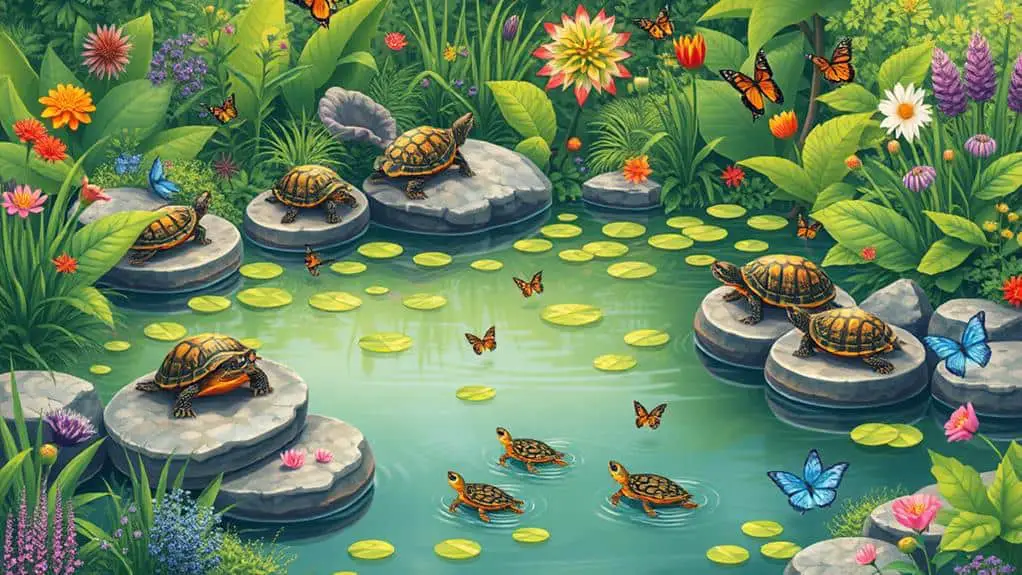
Creating a turtle-friendly yard not only aids in conservation but also transforms your space into a thriving habitat. By engaging in conservation techniques, like creating a clean water source, you provide essential habitats for turtles, supporting biodiversity.
Avoid releasing pet turtles into the wild to maintain ecological balance and prevent competition with native species. You can also help by using natural pest control methods, enhancing your yard's health and contributing to turtle well-being.
Participating in local conservation efforts and habitat restoration projects can protect endangered species like the western pond turtle. Community involvement in awareness campaigns further supports these initiatives, ensuring a healthier environment for turtles and other wildlife.
Let's work together to make a difference!
Nesting Significance
Supporting turtle conservation in your yard also involves recognizing the importance of nesting. Nesting habitats are essential for a turtle's reproductive success, as mother turtles have relied on their instincts to find the perfect sites for over 200 million years. They use visual cues, scent, and soil quality to choose these spots.
However, many local turtle populations are declining due to nesting failures. That's why protecting these habitats is critical for successful reproduction. Understanding their nesting behavior helps in developing effective conservation strategies, ensuring hatchlings survive and populations recover.
Spring is the key nesting time, so it's important to monitor and safeguard these sites from predators and disturbances. Your yard can make a real difference!
Habitat Modifications
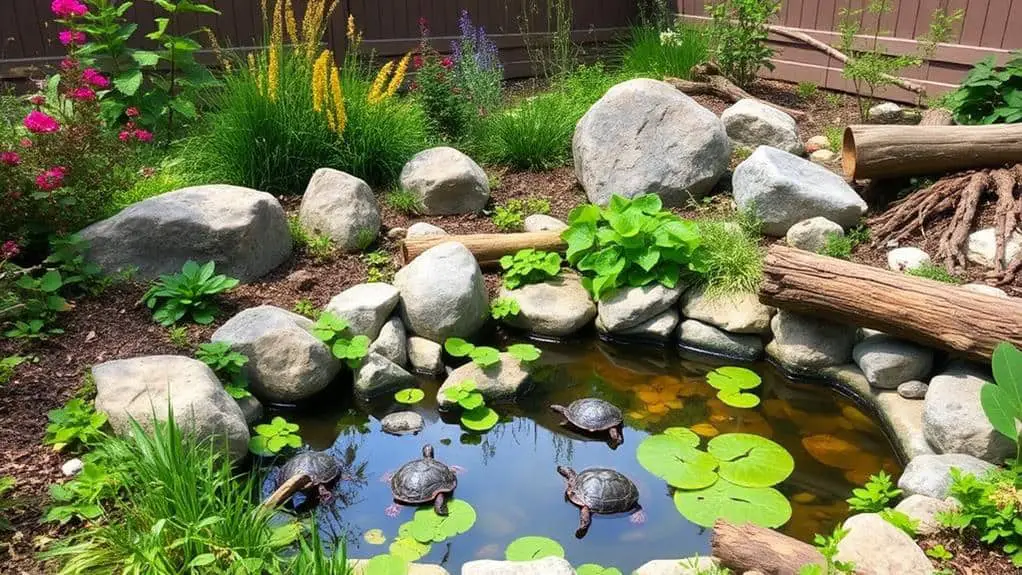
While modifying your yard to support turtle conservation, it's crucial to create environments that cater to their natural behaviors and safety.
A good habitat design includes shallow bog areas where turtles can comfortably soak and display their natural behavior. Raising the sides of ponds helps keep land turtles safe by limiting access to deep water, preventing drowning.
Installing ramps made from boards or rocks offers turtles an easy way to crawl in and out of water bodies. You can use chicken wire or higher rock barriers to prevent them from entering dangerous areas while still enjoying their habitat.
Adding flat-ended ramps ensures turtles can move and bask, meeting their preferences and promoting ecological balance.
Community Support and Resources
Engaging with community support and resources can greatly enhance your efforts in creating a turtle-friendly yard. You'll find that online forums are a treasure trove for advice on turtle care and habitat design. Experienced members often share insights on creating safe environments and solving specific challenges.
By participating in forum engagement, you can ask questions and exchange strategies that help support local turtle populations.
Community events and local turtle rescue organizations are also valuable. They promote awareness and provide essential resources for turtle conservation.
Resource sharing through these groups guarantees you have the best information to succeed. Together, we can make a significant impact on preserving and protecting our neighborhood turtles.
Don't hesitate to reach out and join the conversation!
Frequently Asked Questions
Is It Good Luck to Have a Turtle in Your Yard?
Yes, it's considered good luck to have a turtle in your yard. Turtle symbolism and mythology often link them to protection and abundance. Their presence can also highlight turtle conservation efforts, promoting a healthy, balanced ecosystem.
What Does It Mean to Find a Turtle in Your Yard?
Finding a turtle in your yard often signifies a healthy ecosystem. From turtle symbolism to their behavior, it's a sign of clean water and suitable habitat. They help control pests and indicate nearby nesting sites, promoting biodiversity.
Are Box Turtles Good for Your Yard?
Box turtles are great for your yard. With proper box turtle care, considering their habitat needs and diet requirements, they thrive and help control pests naturally. Their presence enhances biodiversity and indicates a healthy environment.
What Should I Do if I Find a Turtle in My Yard?
If I find a turtle in my yard, I'll observe from a distance to minimize stress. For safe relocation, I'll check local regulations. If injured, I'll contact turtle rescue. Habitat protection is key, so I won't feed it.
Conclusion
Creating a turtle-friendly yard can be a wonderful adventure. By attracting these amazing creatures, you're not just improving pest control but also boosting your local ecosystem. Remember to keep their safety in mind and make small habitat changes to welcome them. You'll soon enjoy watching their fascinating behaviors. Embrace this opportunity and join a community that supports wildlife conservation. Your efforts will make a difference, and you'll find joy in a healthier, more vibrant garden.

